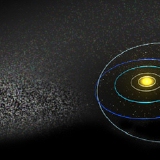 |
|
|
Comet Hyakutake - a visitor from the distant Oort Cloud.
|
|
| KUIPER BELT | |
| One of the long standing questions of astronomy has been: where do comets come from? It is now apparent that there are two main sources of comets - the Oort Cloud and the Kuiper Belt. | |
| Long period comets, those which have return periods of more than 200 years are concentrated far beyond the outer planets. They are concentrated in what is called the Oort Cloud after the Dutch astronomer Jan Hendrik Oort. He built on the initial discovery by Isaac Newton that comets have parabolic orbits. Oort realised in the 1940s that comets are preferentially located in a disk shaped cloud at the edge of the Sun's gravitational influence. The gravitational pull of the Sun is so weak here that passing stars, which may go by on time scales of millions of years, can change comet's orbits and produce random effects. | |
 The location of the Oort Cloud. |
|
| Long period comets include Hale-Bopp and Hyakutake. They appear to visit the inner Solar System on hyperbolic trajectories which are more randomly oriented than those of short period comets. Long period comets can have aphelion distances of 3 million million kilometres and periods of up to a million years. | |
 The orbit of Hyakutake. |
|
| Short period comets like Halley have periods of less than 200 years. In 1949, Gerard Kuiper thought that these might be concentrated at a distance of about 4,500 million to 7,500 million kilometres. Until 1992 the idea of such a ring or belt, referred to as the "Kuiper Belt", was theoretical. | |
| In 1992 David Jewitt and Jane Luu found the first Trans-Neptunian Object (TNO), 6,600 million kilometres from the Sun. It was a faint object, (magnitude 23), and given the asteroid designation 1992 QB1. It is an estimated 320 kilometres across, irregular in shape and reddish in colour. Its orbit is not very eccentric and it is inclined by just 2.2o to the plane of the ecliptic. Since then, many more TNOs have been found. About 10 a year were found for the first few years, but the rate of discovery has accelerated dramatically. By the first half of 1999 more than 180 TNOs had been found with at least 70 discovered in the first six months of 1999. There are an estimated 35,000 Kuiper belt objects, 100 to 760 kilometres across, orbiting the Sun at a distance of 4,500 million to 7,500 million kilometres. There are very likely many more beyond. | |
 The location of the Kuiper Belt. |
|
| The reflectance spectra (a recording of the light reflected and absorbed) of the Kuiper belt object 1993 SC shows that it absorbs the same wavelengths of light as Pluto. This indicates that both surfaces comprise, among other things, frozen carbon dioxide and methane. Though Pluto is bigger (2400 kilometres across), such findings are fuelling the debate as to whether Pluto is worthy of the status of planet or whether it should be designated an asteroid. The example of 2060 Chiron shows that there is no rigid distinction between asteroids and comets. Some asteroids may contain volatiles, liquids and gases mixed with their rocky structure, while many asteroids may in fact be former comets which have been depleted of their gas and liquid reserves in successive encounters with the Sun. | |
|
|
|